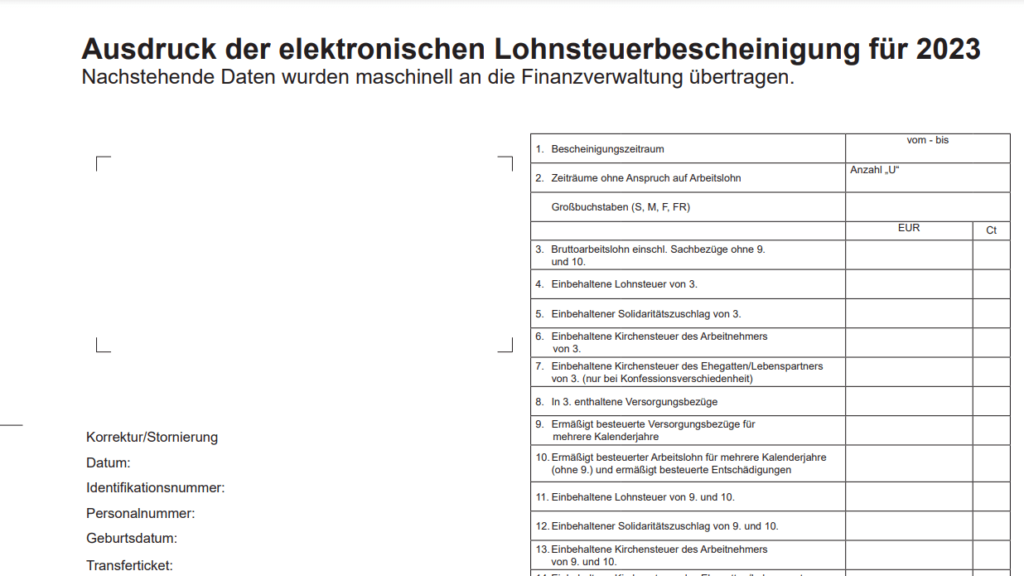Germany’s tax system is structured around tax classes, which play a significant role in determining the amount of income tax an individual pays. Tax classes are crucial, especially for married couples or individuals wanting to optimize their tax burden. Changing your tax class in Germany involves a few specific steps, and understanding the process can help you navigate this aspect of the country’s tax system more efficiently.
1. Understanding Tax Classes in Germany
In Germany, there are six tax classes, each with its own tax rates and implications. Tax classes are primarily designed to account for individual circumstances, such as whether one is married, single, or a single parent. The following is a short overview on each of the available tax classes. For more details have a look at different tax classes in Germany.
- Class I: Applies to single individuals or those who are divorced or widowed.
- Class II: For single parents. This class usually results in lower tax deductions.
- Class III: Primarily for the higher-earning spouse in a married couple.
- Class IV: The most common class for both partners in a marriage or civil union.
- Class V: Applicable for the lower-earning spouse in a married couple.
- Class VI: For individuals with multiple employments or pensions.
2. Reasons to change tax class in Germany
2.1 Marriage or Divorce
- Marriage: When two individuals get married, they are automatically assigned tax class IV, the most common choice for married couples. However, couples can opt for a more favorable tax class combination (III/V or IV/IV) based on their financial situation. If one spouse earns significantly more than the other, classes III/V might be more advantageous due to the lower tax burden for the lower-earning partner.
- Divorce: Following a divorce, each partner reverts to tax class I unless there are dependents involved. In such cases, adjusting the tax class becomes important to manage individual tax responsibilities effectively.
2.2 Income Discrepancies
- Varying Income Levels: In cases where one spouse earns substantially more than the other, changing the tax class to III/V or IV/IV can result in a more equitable distribution of the tax burden. This may lead to lower overall tax payments.
2.3 Parenthood
- Birth of a Child: When a child is born, it often leads to a change in tax class. For single parents, tax class II is more beneficial as it allows for additional tax relief. For couples, shifting to class III/V or IV/IV can provide more advantages in terms of tax benefits.
2.4 Employment Changes
- Multiple Jobs: Individuals holding more than one job are automatically assigned tax class VI for the additional employment. Adjusting the tax class can help balance tax payments and potentially avoid overpayment or underpayment of taxes.
3. The two different ways of changing tax class in Germany
Changing your tax class in Germany can be done through both online and offline methods. Each method has its own advantages and considerations. Here’s an in-depth look at both online and offline approaches to changing your tax class:
3.1 Online Method
Elster Online Portal
The Elster Online Portal is the primary platform for managing your tax affairs in Germany. Changing your tax class online through Elster is a convenient option. Here’s how to do it:
- Eligibility: Ensure you are eligible to change your tax class, considering factors like marriage, income discrepancies, or other life events.
- Create an Elster Account: If you haven’t already, you need to create an account on the Elster Online Portal. This will require providing your personal information and obtaining a login credential.
- Access the Appropriate Form: Once you’re logged in, find the form for changing tax class. It’s usually named “Antrag auf Steuerklassenwechsel bei Ehegatten” (Application for Changing Tax Class for Spouses).
- Complete the Form: Fill out the form with the required details, which may include your personal information, tax identification numbers, and the desired tax class combination.
- Submit the Form: Electronically submit the form through the Elster portal. Ensure that all information is accurate.
- Receive Confirmation: After successful submission, you should receive a confirmation or acknowledgment from the system. This may include a reference number or a confirmation email.
3.2 Offline Method
1. Visit Your Local Tax Office (Finanzamt)
Changing your tax class offline involves physically visiting your local tax office. Here’s how you can do it:
- Eligibility: As with the online method, ensure you are eligible for a tax class change.
- Obtain the Form: At the tax office, ask for the “Antrag auf Steuerklassenwechsel bei Ehegatten” form or any other relevant tax class change form.
- Complete the Form: Fill out the form manually with accurate information, following the same details as the online form.
- Submit the Form: Submit the completed form to the tax office. Both spouses must sign the form, and it’s advisable to do this jointly.
- Await Confirmation: Upon submission, the tax office will process your request. Once approved, you will receive a confirmation or a new tax card reflecting the updated tax class.
4. Important Considerations for Both Methods
- Timing: Changes in tax classes can only be made before the end of the any month and will usually come into effect from the following month.
- Employer Notification: Inform your employer of the change in tax class, but your payroll provider will be notified directly via Elster.
- Consultation: If in doubt or if you encounter any issues, reaching out to the tax authorities or seeking professional advice can be immensely helpful.
Both online and offline methods provide a means to change your tax class in Germany. The choice between these methods depends on your preference, access to technology, and the complexity of your tax situation. Whichever method you choose, it’s important to ensure the accuracy of the information provided and consider the implications for your overall tax situation.
Conclusion
Understanding the German tax system and the implications of different tax classes is crucial for individuals looking to optimize their tax situation. Changing your tax class involves a relatively straightforward process, primarily through the submission of a form to the local tax office. It’s essential to consider your circumstances and consult with a tax advisor or the tax office to ensure the most beneficial tax class for your situation.
By following these steps and understanding the nuances of the tax class system in Germany, individuals can navigate the process of changing tax classes more effectively, potentially reducing their tax burden and optimizing their financial situation.


